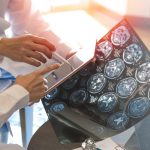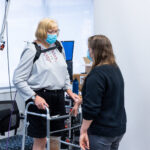A study published in this week’s New England Journal of Medicine revealed that a device called Inspire® Upper Airway Stimulation (UAS) therapy can help reduce sleep apnea episodes by up to 70 percent. For the 12 million Americans with obstructive sleep apnea (OSA), this could be life-changing news.
OSA is characterized by repeated episodes of upper airway collapse during sleep due to narrowing or blockage. This can cause patients to stop breathing during sleep. Repeated episodes of apnea can lead to daytime fatigue, increase a person’s risk for heart attack, stroke, high blood pressure and even death. Treatments include weight loss, upper airway surgeries, oral appliances, and continuous positive airway pressure (CPAP), which is considered the primary treatment for OSA. But unfortunately, due to the discomfort with the CPAP mask and having to be tethered to a machine, up to 50 percent of patients don’t use it.
Patients who participated in the multicenter apnea study, led by Patrick Strollo, M.D., professor of medicine and clinical and translational science at the University of Pittsburgh School of Medicine and medical director of the UPMC Sleep Medicine Center, all underwent surgery to implant the device. The device stimulates the nerve of the tongue during sleep, thereby enlarging and stabilizing the airway and improving control of breathing.
Here, we ask Al Friedl and Kathy Gaberson, both part of the trial that tested the Inspire therapy, about their experiences with OSA and with the new technology.
Q: What was your experience with sleep apnea before you started using the Inspire device?
Al: I had a horrible sleeping experience. The idea of sleeping through the night was non-existent, and when nighttime came I was terrified. I finally heard about CPAP and my experience was better, but not ideal – I never got used to the thing, and had to wait until I was drop dead tired to use the machine. Some people like the snug effect of the machine, but not me. I used it for 5 or 6 years, and then switched to using a simple mouth guard which provided the same function but was a little more comfortable. But it still wasn’t ideal.
I then found out about the Inspire therapy through my brother, who had read an article about the trial. I called and decided to check it out, then heard from UPMC’s Ear Nose and Throat division and after a few rounds of evaluation, the device was installed during surgery.
Kathy: After I was diagnosed with OSA in 2007, the only option for treatment was the CPAP. So I acquired the machine and started using it even though it was not comfortable and not convenient – I didn’t like waking up with a sore nose and indentations on my face. Still, I persisted and was very faithful in using the equipment. But it was cumbersome since I traveled frequently for my job and had to bring the CPAP device on the plane, since you can’t check it. After five years of use, I was frustrated and found a new sleep medicine doctor to talk about other possible treatment options, which is when I learned about the Inspire device trial.
Q: What is life like now?
Al: After a few tweaks of getting the stimulation “dosage” to be right for me, I feel so much better. I sleep through the night almost every night. There are only a few nights each month where I don’t sleep well, but I’m 83 so that’s pretty good!
Al: After a few tweaks of getting the stimulation “dosage” to be right for me, I feel so much better. I sleep through the night almost every night. There are only a few nights each month where I don’t sleep well, but I’m 83 so that’s pretty good!
Kathy: Once the device was turned on after a month of healing post-surgery, I gradually felt better and better until we reached the ideal settings for me. I noticed that the quality of my sleep was much better than with the CPAP. I went from having 23 apnea events per hour to just two. I also had a lot more energy during the day. My short-term memory improved, too, and it made a huge difference for my quality of life. The memory problems were frustrating not just for me but also for people I worked with.








